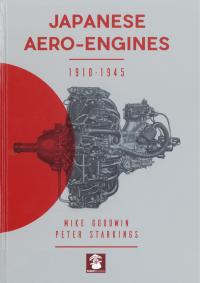
Japanese Aero-Engines 1910 - 1945
by Mike Goodwin, Peter Starkings
Hardbound, 8.3" x 11.7" x 0.7", 216 pages
ISBN-13: 978-8-365281-326
MMPBooks (April 24, 2017)
Recommended Retail Price: £30.00
pictures/diagrams, black and white
Book Reviews 3
 |
Japanese Aero-Engines 1910 - 1945 Hardbound, 8.3" x 11.7" x 0.7", 216 pages Recommended Retail Price: £30.00 pictures/diagrams, black and white |
Reviewed by George Rowley - 2 Aug 2017
Here is a new treasure.
Japanese Aero-Engines describes a multitude of engines, certainly over a hundred, in as much detail as the authors have been able to find over years of research. Their information is clearly organized and is communicated in direct, plain and straightforward language, so there is no wondering what they meant. Plenty of tables throughout make it easy to compare different engines, or different variants. Most chapters are provided with insightful summaries at the end, which could serve the reader just as well as introductions. All the photos (black-and-white) are large, clear and sharp.
Japanese Aero-Engines has no wasted space at all. There is one flyleaf. The next page is the title page; on its other side are the table of contents and the publishing information. The very next page begins the story. Each page is full of text and lots of information. The pages feel thin as if careless handling might rip the paper, but the paper is slick and the print does not show through from the back. The authors are British so there are no language translation issues.
Of course, nothing is perfect. The things that bothered me were all minor:
There are a few typos, but the only two I spotted that have any factual value are in Table 2/2, where the Kotobuki engine is given Type Number 975, instead of 97, and in Table 2/7, where the Hiro Type 91 engine is attributed to operational use in E7K aircraft in general instead of in the E7K1 only. Too many words are meaninglessly interrupted by hyphens not cleared after formatting the text.
Measurements are in metric ISO units only. For English values, use 25.4 mm per inch, 61 cubic inches per liter, 2.2 lbs for a kilogram, and 3.28 feet in a meter (for performance altitudes). English and metric horsepower are essentially identical. Happily, the authors don’t give power in kW.
Despite all the cross-referencing tabulations of engine types, and tables that reference engine types to the aircraft in which they were used, there is no list that lets you look an aircraft up to find out what engine it used. For this, you must go to another source, either Japanese Aircraft 1910-1941 by Mikesh and Abe, or Japanese Aircraft of the Pacific War by Francillon, or look on the Web. Many of the tables continue from one page to the next, but on the second page, the column headings don’t repeat. You will have to go back to the first page, count over to the column you want, then count to the same column on the second page.
But never mind these minor complaints. This book has taken a seemingly indecipherable subject and laid it out plain and clear. Japanese Aero-Engines will absolutely be the long-term basic reference for Japanese engines in the same way as Mikesh & Abe and Francillon are for aircraft.
Amazon claims the list price is $59, but they are selling it for $34, which is a serious bargain for the tremendous amount of information in it. The publisher is a small specialty publishing house who seem to have a philosophy of small print runs. So if you think you may want a copy, you’d best get it sooner. If you’re not sure, the following description may help you decide.
The introductory material defines some of the problems in studying the subject. While there hasn’t been much written in English about Japanese aircraft engines, there hasn’t been a lot published in Japan either. There are difficulties in the translation of terms into English, and problems with engine nomenclature from a plethora of designation systems. We also have painted for us a general view of aviation manufacturing in Japan, including the two broad phases into which it naturally divides. Various difficulties largely unique to Japan that affected the aero engine industry are described as well.
The first chapter tells how aviation activities started in the pioneer era in Japan as they did elsewhere in the world. No one event stands as a milestone for the beginning of aero engines, so the date of 1910 in the book’s title is an approximation. The engine-building efforts of early pioneers are described, followed by a description of how Japan, at peace, benefitted from advances made in the Western world enmeshed in a Great War.
The authors then provide us a chapter to clarify the nomenclature of Japanese engines. I describe this chapter in some detail to give a flavor of the book as a whole. This has always been a confusing topic because there were far too many name systems. The authors solve the problem by clear organization.
Wisely setting aside the various manufacturers’ own product nomenclatures until the individual company chapters to follow, the authors go the source of the confusion, which lay with the military. The Army used one system called Type Numbers, which were based on the year of the ancient and traditional Japanese calendar—the same Type Numbers as for aircraft, armored vehicles, guns, and other equipment—and another system that assigned a Ha-number to each engine; Ha is the first part of the Japanese word for engine. The Navy also used a Type Number designation system, which matched the Army system much of the time, but sometimes not. They also used a popular name designation system (Kotobuki, Zuisei, Atsuta). A third Navy method was a Short designation system, with each engine assigned a letter-letter-number nomenclature, similar to the way the Navy gave each aircraft type a letter-number-letter Short designation. Fourth, there was also a Shi-number system that tracked each new Navy experimental engine project.
Since many engines were used by both services, the resulting confusion led them to clean it up—by introducing yet another system. This Joint system used a Ha-number like the Army’s system, but with each engine assigned a new, different number! The authors keep these two Ha- systems clear by writing the Joint Ha- numbers in square brackets. Thus, the [Ha-12] was a completely different engine from the Ha-12 without brackets.
There are various tables which sort and cross-reference the engines by each designation method and also show which airplanes they were used in, separated by their use in prototypes only, in service, and in proposed projects.
The remaining chapters are organized by manufacturer. The first of these, on minor manufacturers, goes beyond the title to add suppliers of components to the aero engine industry. There are three suppliers of bearings, five carburetor manufacturers, a company who specialized in exhaust valves, and so forth. For many we are given just the names and locations of these companies; a few others have a brief story told. Propellers and superchargers get about a page each. If the propellers on Japanese aircraft look familiar, it’s because the majority were Hamilton Standard, under pre-war license. Other propellers were built under licenses from VDM and Ratier.
Aichi and Kawasaki are covered together, despite having no business relationship, because they both eventually built the DB 600 and 601 under license. Having the two companies in the same chapter lets the authors readily compare the two products. Their earlier histories, when they built entirely different engines, are described individually. There are some nice black and white photos.
Gasuden and Hitachi are also covered together, for a different reason. Gasuden was an acronym for Tokyo Gas & Electric, which sounds like a utility company, but it was a technology company, founded in 1910 to make “valves and vacuum tubes” (valve being the British name for vacuum tube). Within just a few years Gasuden had expanded into other new technology areas, including the licensed building of foreign aero engines for the Japanese military. They soon were building their own engine designs. In 1939 they were merged into the Hitachi airframe company. The Gasuden name was changed to Hitachi, while airframe work continued at Hitachi’s factory in the city of Tachikawa. Hitachi engines were in the smaller range, from about Kinner-size to Wasp Junior size, and powered most of the trainers and some reconnaissance and small transport aircraft. Surprisingly, there are no photographs, although examples of Hitachi engines survive in airplanes in several museums in Asia.
The chapter on Hiro and Yokosuka engines is one of the shortest, with eight pages. The two are treated together because they were both Navy organizations, while all the other manufacturers were commercial. Hiro (not to be confused with the WW1-era Hiero engines from Austria) had a successful series of W-12s and a W-18 which they developed after license production of Lorraine W-12s. Hiro’s engines were substantially different. Detailed descriptions are provided, with information that isn’t available anywhere else. There are no photos.
Now we come to the two biggest manufacturers, Mitsubishi and Nakajima. Each of these occupies two chapters, divided into pre-war and Pacific War parts, and total 43 and 60 pages respectively. Each engine subtype is described, and there are photos throughout.
Jet engines get attention in the final chapter. This devotes sixteen pages, with photos, to the story of rockets (solid and liquid), a pulsejet, a ramjet, a motorjet, and various turbojets. There is also a short mention of a turboprop engine. The German contribution is described.
The first two appendices list Army and Navy aircraft by their Short designations. Unfortunately, this omits all aircraft types before the Short designation systems were created. Another appendix adds a comprehensive list of Japanese terms translated into English, such as aircraft names, engine names, and the names of associations, companies, government offices, etc. There is an index of engines, broken down into categories and subcategories, which means that to look an engine up, you will have to look in the right place. A bibliography is last.
 |
Piston Aero Engines e-Book, 86 pages Price: €14.00, delivered via file transfer B/W & Color illustrations, CAD images and animations |
Reviewed by Kimble D. McCutcheon - 5 March 2015
Ugo Vicenzi, who joined the AEHS during its first year, has been a regular contributor of articles for its Journal and CAD drawings for its web site. Now Vicenzi has produced an e-Book of CAD drawings and animations covering four engines: the Curtiss-Wright R-3350TC, the Bristol Hercules, the Isotta Fraschini IF-750, and the Fiat A-80.
Each engine article includes a detailed illustrated narrative describing its development history, technical details, and aircraft applications. Numerous CAD drawings show each engine's construction features. Videos of R-3350TC and Bristol Hercules startups are included.
The animations take two forms. There are ones that show the moving parts in motion. But the real treat is a disassembly sequence for each engine. These are spectacular works of art, beautifully rendered with impressive detail that includes reflections, pans and zooms, and perspective transitions as components separate from the engine. Each disassembly sequence is accompanied by an engaging music score.
Vicenzi's introduction pays homage to famous cutaway artists, such as Max Millar and JH Clark, whose work was featured in numerous manuals and magazines, including Flight magazine. A final page explains how the drawings and animations were done, and mentions that each required between 300 and 600 hours to complete.
This e-Book takes the form of a compressed (.zip) Adobe® Flash® file (.swf) that is nearly 634MB in size.
I thoroughly enjoyed reading and viewing this.
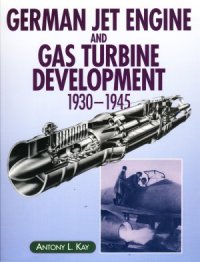 |
German Jet Engine and Hardbound, 296 pages |
Reviewed by Douglas Culy
A. L. Kay's book on German turbine engines is a major addition to the literature on German engines. Not only does he cover the jet engines we already knew about in more detail than any other author this reviewer has read, but he also reveals German work on automotive, marine, and industrial engines. This seldom-mentioned additional engine development should not be surprising, since such work was also going in other countries. There are nine sections of discussion:
Introduction — Pre 1930 work, government procurement organization, methods of procurement, and definition of the engine type (qualification) test.
Gas Turbines for Aviation — turbojets, turboprops, and turbofans by Heinkel, Junkers, BMW, Daimler Benz, and Porsche are covered, with many photos not seen before. There also many sketches of engine component details, and coverage of all engines known to have been studied, even if not built and run.
Gas Turbines for Land Traction — Porsche studied a gas generator with adjacent and remote power turbine and with and without staged combustion and recuperation. Two forms of these turboshaft engines were in detail design at the end of WW2, and cross-sections are presented.
Gas Turbines for Industry — Brown Boveri built and Thyssen Steel operated an experimental constant-volume (pulsed flow) engine to run a generator. Brown Boveri also built and operated combined conventional steam and gas turbine units for generating electricity, steam, and blast furnace gases. MAN adapted its work on the marine turbine, adding waste heat recovery, for power generation. Studies (only) were carried out by several other builders, including AEG (German General Electric).
Gas Turbine Research and Development — Compressor, combustor, turbine, and system development was carried out by many research organizations in Germany. These efforts and a free-piston barrel engine (a picture is included) are discussed.
The Jet Helicopter — The Doblehoff helicopter with tipjets on the rotor blades was built and flown. It is discussed and illustrated.
Pulsejets for Aviation — Both the Argus and Schmidt pulsejet engines are discussed in detail, with photos and drawings; and airframes tested with pulsejet engines, in addition to the V-1, are discussed and illustrated.
Ramjets for Aviation — Ramjet engines from Walter, Trommsdorf, Sanger, Focke-Wulf (Pabst), and BMW are discussed and pictured, including one with intercontinental capability.
German Jet Engine and Gas Turbine Development 1930-1945 is a very satisfying book and well worth its price. As typically occurs, there are a few places where the author's data is different from that presented in other books. This reviewer will leave it to the reader to judge those differences.
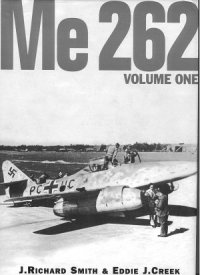 |
Me 262 Volume One Classic Publications |
Reviewed by Douglas Culy
The great airplanes have many books written about them. This writer has six major works on the Messerschmitt 262, and each has something a little different to say. Smith and Creek's book has something of particular interest to engine history buffs, which is that the three jet engines that influenced the design of the Me 262 are very well covered (BMW P3304, BMW P3302 (003), and Jumo 004). The BMW 003A, a different engine from the P3302, which flew in later Me 262 development aircraft, is also discussed, although it did not influence the airframe design. In fact, this book has the most detailed coverage of the BMW P3304 (the one that never ran) that this writer has seen in any book on German jet engine development. Specifically, it gives the size of the engines and well illustrates the installation of each of these successively larger engines in their nacelles and in the also-evolving wing of the Me 262. Further, this book has many photos of wind-tunnel models that were prepared to evaluate the several stages of airframe design that began with what looks like a straight-wing Me 309 derivative or cousin and ended with the all-new swept-wing fighter that was produced.
This volume covers development of the airplane, with discussion of the first 17 prototypes and the initial production methods. Chapter headings are:
1. The Skull of a Genius
2. Some Thought My Ideas Were Pure Fantasy
3. A Fever of Expectation
4. An Unimaginable Lead
5. Projected Me 262 Developments
6. I'm Not Interested In This Aircraft As A Fighter
7. We Need the Me 262 More Than Anything Else
Appendix. 1. Camouflage and Markings
Appendix. 2. Me 262 Prototype Flights
Appendix. 3. German Reaction Engine Designation System
Appendix. 4. Messerschmitt Personalities and Company Organization
Me 262 Volume One is a very satisfying book, and well worth its price. Unfortunately, Volume Two is unavailable, and Volume One and Volume Three may not be on the shelves much longer. Maybe if we all write to the publisher (now Ian Allan Publishing in England), they might reissue the books.
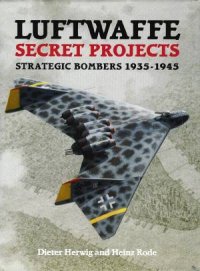 |
Luftwaffe Secret Projects Hardbound 144 pages |
Reviewed by Doug Culy
Luftwaffe Secret Projects — Strategic Bombers 1935-1945 begins each chapter with biographies of designers and Luftwaffe leaders in the procurement departments. There are many excellent photographs, line drawings, and color illustrations of actual aircraft, formal projects not completed, and designers' ideas. The latter border on the fantastic, but are supplemented with convincing discussion, including which engines were planned for that aircraft. In the Appendices contain photos of wartime wind-tunnel test facilities, and 24 very clear photos of advanced piston and jet engines. The piston engine photos are usually of the aft end, showing the supercharger and turbocharger installations. There are also photos and drawings of guided missiles.
When examining the book prior to purchase, this writer was initially skeptical, but was pleasantly surprised at the obvious quality and thoroughness of the coverage. Herwig, the principal author, was employed in the RLM during WW2, and later was an aviation historian. It is well worth the list price of US $39.95, and can be had for less from on-line discounters.
Table of Contents
Glossary
Notes
1. Heavy Bomber Development in Germany up until 1945
2. Bomber Projects of the Reichswehr 1926-1933
3. Heavy Bomber Projects 1933-1937
4. Prototypes and Projects in the Bomber-B Program
5. Strategic VLR Reconnaissance Aircraft and Guided Missile Carriers
6. Target New York — Strategic Heavy and Long-Range Bomber Projects 1942 to 1944
7. Long- and Very Long-Range Jet Bomber Projects 1944 to 1945
8. Tactical Bomber Projects 1944 to 1945
9. Strategic Long-Range Flying Boat Projects
10. Allied War Booty
Appendix
Index
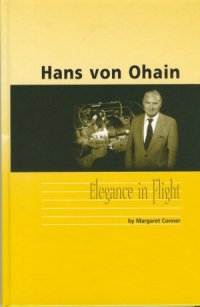 |
Hans von Ohain - Elegance in Flight Hardbound, 285 pages |
Reviewed by Tom Fey
Hans Joachim Pabst von Ohain designed the first jet engine to successfully power an aircraft (Aug. 27, 1939) and for that reason alone, the biography of Dr. von Ohain, Elegance in Flight, written by Margaret Conner is a valuable addition to the aviation literature. The book nicely chronicles von Ohain's life before this momentous achievement as well as the subsequent decades of his life until his death from heart failure in 1998.
Born into an affluent military family in Dessau, Germany, von Ohain was interested in many things as he grew up; sailing, cars, etc. Having earned doctoral degree in physics (dissertation: optical microphone) from Georg-August University, Gottingen, Germany, in 1935, von Ohain came to believe that there must be a better way to power aircraft than the noisy, vibrating, heavy, and complicated reciprocating engines of the day. This interest leads to theoretical studies during his graduate and postgraduate years, and eventually the construction of a prototype by his friend/machinist/auto mechanic, Max Hahn. The prototype was unable to run independently, and short of money and resources to continue his work, von Ohain's professor suggested he try to secure financing from an aircraft manufacturer.
Fortunately, von Ohain and Hahn were hired by aeronautical industrialist Ernst Heinkel in early 1936 to develop a flight-worthy jet engine as soon as possible. The account of von Ohain's years at Heinkel before and during the war make very interesting reading, and the highlight of the book for me. Funded, goaded, cloaked in secrecy, and micro-managed by Ernst Heinkel himself, the jet engine team lead by von Ohain was tasked with making Heinkel a player in jet aircraft. Hans von Ohain's degree in physics didn't completely prepare him for the demands and diverse complexities of metallurgy, manufacturing, material science, and aeronautics, but his gifted intellect and respectful demeanor helped him learn rapidly on the job from a wide-ranging cast of characters at the Heinkel works. The biography is not overly technical with regards to the design and execution of a jet engine, but I found a pleasant amount of detail to keep the reader engaged with the engineering challenges and progress embodied in the Heinkel series of jet engines. There is an appendix with nine pages drawings of the first flight engine, the He3B, and several other jets engines as well.
Like many German experts in the aeronautical and engineering fields, von Ohain was recruited by the US government to come to America after the war to continue his work. Settling first in Alabama, and eventually Ohio, von Ohain used his considerable intelligence, determination, and gentle charisma to advance himself and his programs in government service, rising to the directorship of the Advanced Propulsion Laboratory in Dayton, Ohio. The adaptation to the language, customs, and systems of American life were enjoyable reading.
There are not a lot of other references in the literature that document von Ohain's life, so it is difficult for me to gauge the accuracy of this biography. The only obvious error I came across was the author stating that Americans were first to orbit Earth (Yuri Gagarin of the USSR was the first human to enter space and to orbit the Earth, both occurring in his pioneering flight on April 12, 1961).
After reading an article about von Ohain in the late 1980s, I was able to contact him by mail to ask a few questions about the first flight engine. The very kind letter I received back from Dr. von Ohain seems to nicely fit the persona described in the book, and remains a prized document in my aeronautical collection.
I very much recommend the book to those interested in the genesis of jet flight, and it makes a nice compliment to the several books written about the British jet pioneer, Sir Frank Whittle. For those wanting additional technical detail and pictures of the German jet engines, I would recommend The First Jet Aircraft by Wolfgang Wagner (Schiffer Publishing, 1998) and German Jet Engines and Gas Turbine Development 1930-1945 by Antony L. Kay (Airlife, 2002).
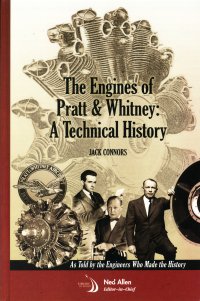 |
The Engines of Pratt & Whitney: Hardcover, 6.3" x 9.2", 548 pages Recommended Retail Price: US $49.95 Photos, drawings, charts, and diagrams |
Reviewed by Doug Culy
Jack Connors’ book is by far the most interesting book yet written for aircraft engine development engineers interested in the history of the business as well as that of the engines. This so because Jack Connors IS one, as is this reviewer. It should also be quite entertaining for any other lover of engines. Connors provides anecdotes, timelines, component data, problems and solutions, people insights, a few program costs, and many, many charts and tables to satisfy the technically curious. The bottom line is that The Engines of Pratt & Whitney is worth far more than its price.
The book has 511 pages, not including the index, of which 159 cover the piston engines, with 352 pages covering almost all of the turbine engine programs (rockets too). Connors arrived at P&WA in 1948, retiring in 1983, and worked on the jet engine programs at the lowest and very high technical and managerial levels, so he has many perspectives of what and why things happened.
His discussion of the PT-1 provides an order of magnitude more pictures and information on this free-piston compressor-driven turbine than has been seen before. He provides a little more data on the PT5/T57 to give us some more understanding of the engine that should be on the A400M. Connors greatly illuminates the mysterious 304 hydrogen turbojet, and gives terrific coverage to the big well-known programs. For these, there are also many little-known tidbits provided.
The coverage of the piston engine programs is not nearly as satisfying, mostly because there are few, if any survivors to give insights, and Connors worked mostly if not entirely on turbines. The R-4360 is described, as is the little-known R-2180E, but nothing of value is provided in the three paragraphs on the R-2800. Don’t let this deter you from reading the book, as the widely revered The Development of Aircraft Engines by Schlaifer has huge gaps that don’t hurt its value as a reference.
Table of Contents Acknowledgements |